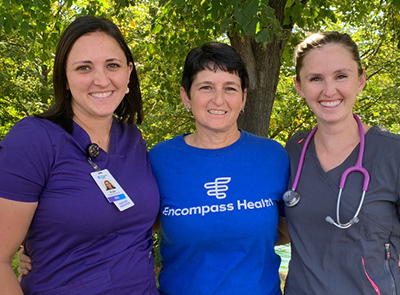Weber State Hosts Second National Summit on Dual-Mission Institutions
OGDEN, Utah – The path to higher education is sometimes steep. The goal of Utah’s three dual-mission institutions is to provide educational steps, so students have flexibility to earn certificates and advance from associate to bachelor’s to graduate degrees.
The dual-mission model has gained national and even international attention. Weber State University will host the second National Summit on Dual-Mission Institutions in Higher Education: Sparking Success on Oct. 7 from 8:30 a.m-7 p.m. in the Shepherd Union Building.
The daylong summit will feature perspectives from students and faculty, workforce and government executives, and higher-education leaders from around the country.
One of the panelists, Weber State alumnus Tammy Buckway, will tell her story: how a divorced mother of seven with five part-time and seasonal jobs ended up back at school.

Angie McLemore, Tammy Buckway, Valerie Rodgers
“The director of the nursing program asked me, ‘Why not? In three years, you’ll have a degree and a career that will allow you to support your family,’” Buckway remembers. “She was right. I had to overcome poor grades from my first few semesters right out of high school, but thanks to the flexibility of the program, I was able to pick a path that allowed me to quickly advance.”
Buckway eventually earned her associate in nursing from Weber State, her Practical Nurse (PN) from Davis Technical College, and her Registered Nurse (RN) and master’s in nursing from Weber State. Now, she is a hospice nurse as well as an adjunct clinical instructor. She has her application started for the new Doctor of Nursing Practice at Weber State.
Best of all, she said, her children have followed her example. Buckway’s oldest two daughters graduated from Weber State in nursing and work with her in hospice care. Her oldest son graduated in chemistry and earned an advanced degree in pharmacy.
“I didn’t have to point my kids toward college,” Buckway said. “I don’t take credit for that, other than I followed my dream and in doing so, part of my dream became an extension of their dreams.”
The conference’s featured speakers will include the presidents of Utah’s three dual-mission universities: Brad Mortensen, Weber State; Astrid Tuminez, Utah Valley University; and Richard Williams, Dixie State University. David Woolstenhulme, interim commissioner of the Utah System of Higher Education, will moderate.
“Dual mission is the heart of Weber State because it enables us to better serve students with whatever skill set and experience they bring to the university,” Mortensen said. “We can then prepare them to live meaningful, productive lives and contribute to Utah’s growing workforce demands, including those in the robust aerospace, healthcare and technology sectors.”
Mobilization assistant to the commander of Ogden Air Logistics Complex at Hill Air Force Base, Brig. Gen. Constance Jenkins, will discuss workforce needs at the base during her 12:30 p.m. keynote lunch speech.
The integrated dual-mission model began with Weber State in 1962, the year it started offering baccalaureate degrees in addition to its two-year degrees as a junior college. Eventually, Weber State also added master’s degrees, and in 1991 became a university.
Utah Valley followed a similar path, transitioning from a vocational school, to a community college, to a state college and then finally a university in 2008. Dixie State, which began as St. George Stake Academy in 1911, later became a state college and, most recently, a university in 2013.
What makes these transitions unique is that the universities never abandoned their vocational and community-college programs. Today, in fact, with the support of the Utah State Legislature and the Utah System of Higher Education and through partnerships with technical colleges, those programs (sometimes referred to as CTE, or career technical education) have grown stronger. Technical education is an integral part of the universities.
The dual-mission model is a savings in both money and time. Curriculum is coordinated, and degrees are “stackable,” allowing students to advance or stack one degree on top of another without losing credits. Although students can transfer their degrees from one institution to another, Utah State Senator Ann Millner, a former WSU president, told last year’s summit attendees that most students stayed to complete their bachelor’s at the institution where they earned an associate degree.
“When you see the outcomes, compare the matriculations, it's significantly better in the dual-mission education model,” she said.
According to WSU's most recent data, 62 percent of students who get an associate degree continue to earn a bachelor's within the institution. That's more than double the national average for students who are transferring from one institution to another and fully in line with the responsibility to fulfill the regional educational demands of a community college.
In addition to everything else, Tammy Buckway said she is now a mentor: She promotes higher education to those who think they do not have the time, money or ability to attend.
“Without my education, I would have found a way to make it work,” Buckway said. “But now I have financial security, am able to provide for a family the way I always wanted to, not paycheck to paycheck, and it’s great. I’m living the dream.”
For more information or to register for the summit, visit continue.weber.edu/dualmission/.
For a photo, visit the following link.
Visit weber.edu/wsutoday for more news about Weber State University.
Allison Barlow Hess, Public Relations director
801-626-7948 • ahess@weber.edu- Contact:
Julie Snowball, WSU Career and Technical Education director
801-395-3473 • juliesnowball@weber.edu
